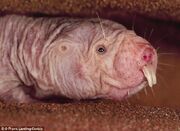
Social Shrimps
Definition[]
A type of evolutionary altruistic strategy in which relatives/family members are willing to work together to protect offspring other than their own, as it helps to propagate a small portion of their genes, and can come at a cost of their own survival and reproduction.
Kin selection[]
Eusocial organization in which sterile individuals care for the colony and sacrifice their reproductive success is a

Naked mole rats are also know to demonstrate eusocial behaviors
paradox by Darwinian natural selection, but can be explained through Kin selection theory which states that selection will favor traits that decrease personal fitness if it increases the survival of close relatives that carry similar geneotype. This theory is tested by Hamilton’s rule which identifies the conditions favoring reproductive altruism. The formula derived by the geneticist and biologist William Hamilton states: r × B > C where B is the benefit (in number of offspring equivalents) gained by the recipient of the altruism, C is the cost (in number of offspring equivalents) suffered by the donor and r is the degree of relatedness of the actor and recipient.
Haplodiplidy which occurs in bees, wasps and ants means that males are haploid and females are diploid. Females are more closely related to their sisters than their own offspring. This is because ½ of their genes are derived from the same father and ½ from the same mother. At the gene level, sacrificing their own reproductive success and perpetuating the reproductive success of their sisters ensures that their genes are successful,( Freeman and Herron 2007, p.460-461; Trivers and Hare 2013).
However the assumptions underlying Hamilton’s rule are not universal. For instance, Honeybee queens are known to mate up to 17.25 times before founding a colony, so all sisters will not have the same father. In some colonies more than one queen is responsible for reproduction, and thirdly, not all Eusocial species are haplodiploid, and not all haplodiploids are Eusocial. Researchers have noted that ecology plays a role in Eusociality as it tends to evolve in groups that build complex nests and whose larvae need extended care, favoring the selection of genes for cooperative and altruistic behaviors (Freeman & Heron 2007, p. 463-464).
References[]
Freeman, S. & Herron, J. (2007).Chp 12: Kin selection and social behavior. Evolutionary Analysis 4th Ed. Form and Function. 447-482.
Trivers RL, Hare H. (1976). Haploidploidy and the evolution of the social insect. Science. 191(4224):249-63.
Write the second section of your page here.